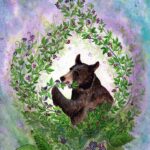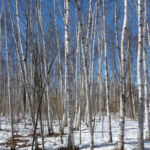Everything changes in this wild place. The ebb and flow of the tides drive the ecology on this rocky shore. The landscape abruptly changes its appearance based on proximity to the sea and elevation. Firs and spruces dominate along with a ground cover of laurel and blueberry. Even old friends, like birch, maple, and beech, take on new skin. The mountain peaks offer a desert-like climate where air and fire dominate. I am in this wild place, letting it seep into my bones, into my breath, into my spirit. Despite the books on ecology I’ve purchased, I really have no idea what I’m seeing, no real knowledge of the deeper mystery of this land and shore. Books cannot teach that kind of wisdom, only time and experience can. My eyes physically see, but I am seeing without any real understanding of what it is that is before me.

Industrialization has taught us that a local context is only a marketing tool, a demographic base through which to sell products. We have eliminated much of what made local contexts unique and have replaced them with the same worn-out stores selling the same worn-out products. But nature has her own wisdom. Nature teaches us that the local context is sacred: it is what gives us distinction, it is what gives us life, it is what roots us in a place. My localized knowledge base, rooted in the Laurel Highlands of Western PA and in the wilds of South-East Michigan, offers me a familiarity and comfort with the plants and animals I know. These are plants and animals that I have developed relationships with over a long period of time. When I enter a forest in my home region, I see my old friends and that relationship deepens. With that deep knowledge of my own ecosystem, an opportunity to visit a new place allows me to begin to understand differences, subtle or major, in new ecosystems.
So, too, as we go deeper into nature-based spirituality and connect with nature through walking the path of the ovate, our landscapes weave into our bodies and souls. These landscapes literally become like skin that we wear, a skin that comes with us wherever we go.
Building Local Knowledge
Indigenous peoples were woven so closely into their landscapes: their landforms, their bodies of water, the local plants. They ate the fish and animals they hunted, they ate the plants they gathered, and they made medicine from what was around them. These elements of their surroundings shaped every aspect of their daily interaction and their culture. They preserved the land and tended the wilds because the land sustained them fully. They understood their landscape in ways no modern human, living indoors, can do. And so, much of that knowledge is lost at present. Certainly, some places in the world, that knowledge still exists–but in places, like where I live, long colonized by those who would seek to destroy native peoples, only fragments remain. In truth, it is likely that modern humans in current western society can never have a deep knowledge, developed from infancy and shared across generations, that humans living in other times or cultures had. But, we can build a start, and we can work to connect once again. In generations to come, we may once again have that kind of deep knowledge of our world. Part of this connection, to me, is the most sacred work there is to do in this world. And part of this is building our own ecoregional druidries and localized understandings.

When we want to learn something today, especially about our local ecosystem, I have found that in-person teachers are often hard to find (and if they can be found, expensive). Books, then, become our teachers, and we can gain much knowledge of the landscape and our local ecology. The knowledge contained in books today was the kind of knowledge we used to have human and non-human teachers teach us: how to identify plants, how to use them for food or medicine, and so on. But there is no substitute for lived experience, the visceral and sensual experience of life–neither of which books can give us. There is no substitute that tells us that the ramps grow in this valley on the eastern side of the mountain where the ephemeral springs open up. Bridging the gap between book knowledge and direct experience is part of what walking the path of the ovate is all about–it is not just about the study of plants, animals, ecology, it is about connecting with that spirit of the landscape, weaving yourself into it, and reconnecting.
Basic knowledge of identification skills and plant families can lead to many deeper understandings, magical understandings, and understanding of the spirit of things. Now that I can identify many plants with ease and know some of their basic features, growth patterns, and uses, I want to understand them deeper. Who do they like to grow next to? What insects live on them? For the trees, what is their wood like? What do they look like at the different seasons of the year? What medicine and magic do they hold? And so, I wonder, wander, and walk through this landscape. A loupe (jeweler’s loupe) in hand offers me a more detailed perspective of the flowers. The more time I spend in the land place, the more I want to simply experience it.
Visiting Somewhere New

When I spent time at Acadia National Park in Maine last year, and recently in the Konza Prarie in Kanas, one thing was clear to me: despite studying field guides that helped me identify plants, to really know either landscape like I knew my own ecosystem, it would take a lifetime. Prior to this, I’ve had no exposure to Maine’s craggy and rocky coasts. I had no experience with the burned out prarie stretching into the distance. Intellectual knowledge in my field guide offers a stepping stone, but true understanding, this weaving into the landscape, would take years of regular interaction and time spent in nature.
While in Maine, I spent numerous hours in the same spot, on a place called Otter Cliff, first observing the spot at low tide, and a different day, watching the high tide come in. I watched the way that the various seaweed adapted to the incoming waves, and how different species lived at different heights and were exposed to different wave actions. A field guide tells me that I’m seeing bladderwrack, rockweed, wormweed, barnacles, and mussels. But yet, nothing but observation can teach me how the waves crash into the bladderwrack, or how it feels in my hand, or how it is adapted to move with the waves that would rend my own flesh from my bones against the rocks.
And this is what visiting a radically different ecosystem can do. You are out of your comfort zone, the plants and animals may be similar, but not exact. It is an extremely good time to study plant families (like through the book called Botany in a Day). Even if you can’t identify the specific plants, you can certainly identify their families, which teaches you new and important skills. This newness and challenge leads to rich rewards, new learning, and growth.

Different regions also have different elemental balances. For example, I live in a land that is dominated by earth and water. The mountains, especially higher up, often have clouds and mist. The forests remain quite damp and the damp-loving trees like Eastern Hemlock are abundant, especially in dark forest valleys where the streams and creeks flow. On the Maine coast, this land is dominated as much by earth and water as it is by air–the winds, of which we have very little, are ever-present here as the waves continue to crash on the rocks. High up on the granite-top mountains, fire and air dominate and life barely holds on. In Kansas, fire and air dominated the landscape–particularly fire–due to the recently burned prairie.
Visiting a new number of ecosystems has me realizing just how much power nature has–I understood her power in the Allegheny mountains in PA, but I have no idea of her power in other places. And the homecoming, of returning back to the place where I belong, is powerful and meaningful–all the more so because you are back in familiar territory, where the plants and animals and ecology is familiar, safe, and comforting.
Weaving with Your Landscape
So, too, as we go deeper into nature-based spirituality, should our landscapes weave into our bodies and souls. They become like skin that we wear, literally, that comes with us wherever we go. We know the call of the birds, we know just how hard the wind is blowing and from what direction. We understand the ebb and flow of the creek and know how the water runs over the stones. The longer we are in the land we are of the land, till we are one in the same. This is what druidry, I believe, is really about–becoming woven so deeply with your own place.



Reblogged this on Blue Dragon Journal.
Reblogged this on Paths I Walk.
Beautiful!
Reblogged this on dreamweaver333.
this is lovely!
[…] via Walking the Path of the Ovate: Building Localized Ecological Knowledge — The Druid’s Garden […]
I grew up in Minnesota in hardwood forests. My father taught me generations of knowledge in land that had been farmed by my family for 5 generations. I knew every stream, tree and plant. I knew the wild animals and insects. Now I live in California and when I came here I instinctively knew many of the trees which should have been new to me. Did the trees whisper to me on there amazing network of roots and fungi? Have I lived here in another lifetime? The secret, sacred knowledge continues.
Lisa, thank you for sharing! I wonder if that is ancestral knowledge you are tapping into! What a great story 🙂
Amazing and beautiful. We should work together here!
Reblogged this on Dennis Galen.
Thank you for posting this. It’s a wonderful piece with information that many need to know about. And a great reminder on my own path to reconnect with the lands that I know, and those that I need to know.
You said “our landscapes weave into our bodies and souls. These landscapes literally become like a skin that we wear, a skin that comes with us wherever we go.” and it is SO true! I can cross paths with someone thousands of miles away from my birth home of Wisconsin and instantly feel that they carry this same energy, almost as if the energy of the land becomes woven into our very DNA…. <3
It's true that a lot of ancient knowledge & wisdom has been lost by modern humans, although I would note that our ancestors still hold this knowledge and it can AND will become available to us (on an individual and collective level) as we become ready to embody it. It is happening NOW! 😀
Plant & Animal Spirits are also some of the best Teachers around, and they seem to hold the oldest secrets & wisdom of the Nature of All Things…. It can be a lot of Work to reach out and build relationships with beings like these, but well worth the time, energy, and effort. (Although I'm quite certain you already know this 😉 )
The world truly is our Oyster, we need only learn how to communicate with it first.
It is so true. The communication seems to be the “rosetta stone” so to speak for learning the ancient wisdom. The plants, land, animals, stones, and so many other living things are here to teach us–if we can only open our minds and hearts to such communication.